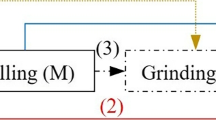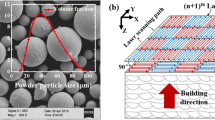Abstract
The use of additive manufacturing (AM) has grown exponentially in recent years and has many advantages, including feasibility, over other conventional processes in many current applications. The use of a second process, for example, machining, improves the surface finish and in this case, the use of two processes is known as hybrid manufacturing. Heat treatments are often performed on parts generated by the AM process, mainly to relieve the residual stresses generated, but for some materials, this can decrease the pitting corrosion resistance of the parts. The objective of this study is to analyze the effect of hybrid manufacturing (AM + machining) on residual stresses and pitting resistance corrosion, which can bring advantages to piece properties without the use of heat treatment. 316L stainless steel parts are generated by direct laser metal sintering (DLMS), with subsequent milling using a complete factorial planning for the design of the experiments. The cutting speed, feed rate, cutting depth, use of the cutting fluid and laser power in the DLMS process are all varied. Residual stresses are measured by X-ray diffraction and the blind hole method, with polarization curves raised by a potentiostat. The results show that it is possible to reduce the residual surface stresses in the parts, even for compressive stresses, and to improve the pitting corrosion resistance, when compared to the part without milling, depending on the cutting parameters used.















Similar content being viewed by others
References
Gonzalez JA, Mireles J, Stafford SW, Perez MA, Terrazas CA, Wicker RB (2019) Characterization of Inconel 625 fabricated using powder-bed-based additive manufacturing technologies. J Mater Process Technol 264:200–210. https://doi.org/10.1016/j.jmatprotec.2018.08.031
Majeed A, Ahmed A, Lv J, Peng T, Muzamil M (2020) A state-of-the-art review on energy consumption and quality characteristics in metal additive manufacturing processes. J Braz Soc Mech Sci Eng 42:249. https://doi.org/10.1007/s40430-020-02323-4
Tadano S, Hino T, Nakatani Y (2018) A modeling study of stress and strain formation induced during melting process in powder-bed electron beam melting for Ni superalloy. J Mater Process Technol 257:163–169. https://doi.org/10.1016/j.jmatprotec.2018.02.033
Megahed M, Mindt H, Dri NN, Duan H, Desmaison O (2016) Metal additive-manufacturing process and residual stress modeling, integrating materials and manufacturing innovation. Integr Mater Manuf Innov. https://doi.org/10.1186/s40192-016-0047-2
Urlea V, Brailovski V (2017) Electropolishing and electropolishing-related allowances for powder bed selectively laser-melted Ti-6Al-4V alloy components. J Mater Process Technol 242:1–11. https://doi.org/10.1016/j.jmatprotec.2016.11.014
Kaschel RF, Celikin M, Dowling DP (2020) Effects of laser power on geometry, microstructure and mechanical properties of printed Ti-6Al-4V parts. J Mater Process Technol 278:116539. https://doi.org/10.1016/j.jmatprotec.2019.116539
Ahmed F, Ali U, Sarker D, Marzbanrad E, Choi K, Mahmoodkhani Y, Toyserkani E (2020) Study of powder recycling and its effect on printed parts during laser powder-bed fusion of 17–4 PH stainless steel. J Mater Process Technol 278:1165–1222. https://doi.org/10.1016/j.jmatprotec.2019.116522
Yan X, Gao S, Chang C, Huang J, Khanlari K, Dong D, Ma W, Fenineche N, Liao H, Liu M (2021) Effect of building directions on the surface roughness, microstructure, and tribological properties of selective laser melted Inconel 625. J Mater Process Technol 288:1168–1178. https://doi.org/10.1016/j.jmatprotec.2020.116878
Webster S, Lin H, Carter F, Ehmann K, Cao J (2020) Physical mechanisms in hybrid additive manufacturing: a process design framework. J Mater Process Technol 291:117–148. https://doi.org/10.1016/j.jmatprotec.2021.117048
Yin S, Yan X, Jenkins R, Chen C, Kazasidis M, Liu M, Kuang M, Lupoi R (2019) Hybrid additive manufacture of 316L stainless steel with cold spray and selective laser melting: microstructure and mechanical properties. J Mater Process Technol 273:116248. https://doi.org/10.1016/j.jmatprotec.2019.05.029
Bobana J, Ahmed A (2020) Improving the surface integrity and mechanical properties of additive manufactured stainless steel components by wire electrical discharge polishing. J Mater Process Technol 291:117013. https://doi.org/10.1016/j.jmatprotec.2020.117013
Feldhausen T, Raghavan N, Saleeby K, Love L, Kurfess T (2021) Mechanical properties and microstructure of 316L stainless steel produced by hybrid manufacturing. J Mater Process Technol 290:116970. https://doi.org/10.1016/j.jmatprotec.2020.116970
Bai Y, Zhao C, Yang J, Hong R, Weng C, Wang H (2021) Microstructure and machinability of selective laser melted high-strength maraging steel with heat treatment. J Mater Process Technol 288:116906. https://doi.org/10.1016/j.jmatprotec.2020.116906
Yang Y, Gong Y, Li C, Wen X, Sun J (2021) Mechanical performance of 316 L stainless steel by hybrid directed energy deposition and thermal milling process. J Mater Process Technol 291:117–123. https://doi.org/10.1016/j.jmatprotec.2020.117023
Moat RJ, Pinkerton AJ, Li L, Withers PJ, Preuss M (2011) Residual stresses in laser direct metal deposited Waspaloy. Mater Sci Eng A 528:2288–2298. https://doi.org/10.1016/j.msea.2010.12.010
Wang Z, Denlinger E, Michaleris P, Stoica AD, Ma D, Beese AM (2017) Residual stress mapping in Inconel 625 fabricated through additive manufacturing : method for neutron diffraction measurements to validate thermomechanical model predictions. JMADE 113:169–177. https://doi.org/10.1016/j.matdes.2016.10.003
Mukherjee T, Zhang W, Debroy T (2017) An improved prediction of residual stresses and distortion in additive manufacturing. Comput Mater Sci 126:360–372
Simson T, Emmel A, Dwars A, Böhm J (2017) Residual stress measurements on AISI 316L samples manufactured by selective laser melting. Addit Manuf 17:183–189. https://doi.org/10.1016/j.addma.2017.07.007
Protasov CE, Safronov VA, Kotoban DV, Gusarov AV (2016) Experimental study of residual stresses in metal parts obtained by selective laser melting. Phys Proc 83:825–832. https://doi.org/10.1016/j.phpro.2016.08.085
Chimmat M, Srinivasan D, Infante V, Deus AM (2019) understanding the residual stress in DMLS CoCrMo and using diffraction SS316L using X-ray diffraction. Proc Struct Integr 14:746–757
Nöbauer H (2018) Residual stresses and distortions in austenitic stainless steel 316L specimens manufactured by selective laser melting. University West, Sweden
Swain S, Panigrahi I, Sahoo AK, Panda A (2019) Study on machining performances during hard turning process using vibration signal under mql environment: a review. Mater Today Proc 18:3539–3545. https://doi.org/10.1016/j.matpr.2019.07.284
Zhang X, Chen L, Zhou J, Ren N (2020) Simulation and experimental studies on process parameters, microstructure and mechanical properties of selective laser melting of stainless steel 316L. J Braz Soc Mech Sci Eng 42:402. https://doi.org/10.1007/s40430-020-02491-3
Andreau O, Koutiri I, Peyre P, Penot JD, Saintier N, Pessard E, De Terris T, Dupuy C, Baudin T (2019) Texture control of 316L parts by modulation of the melt pool morphology in selective laser melting. J Mater Process Technol 264:21–31. https://doi.org/10.1016/j.jmatprotec.2018.08.049
Man C, Duan Z, Cui Z, Dong C, Kong D, Liu T, Chen S, Wang X (2019) The effect of sub-grain structure on intergranular corrosion of 316L stainless steel fabricated via selective laser melting. Matter Lett 243:157–160
LPW Ltd. Technical Data Sheet Powder Range 316L (2017). https://www.carpenteradditive.com/hubfs/Resources/Data%20Sheets/PowderRange_316L_Datasheet.pdf
Duan Z, Man C, Dong C, Cui X, Kong D, Wang L, Wang L (2020) Pitting behavior of SLM 316L stainless steel exposed to chloride environments with different aggressiveness: Pitting mechanism induced by gas pores. Corrosion Science 167:108520
Trelewicz J, Halada G, Donaldson O, Manogharan G (2016) Microstructure and corrosion resistance of laser additively manufactured 316L Stainless Steel. J Miner Met Mater Soc (TMS) 68:850–859
Atapour M, Wang X, Färnlund K, Wallinder IO, Hedberg Y (2020) Corrosion and metal release investigations of selective laser melted 316L stainless steel in a synthetic physiological fluid containing proteins and in diluted hydrochloric acid. Electrochinica Acta 354:136748
Vrancken B (2016) Study of Residual Stresses in Selective Laser Melting, PhD Thesis, Faculty of Engineering Science, KU Leuven
M’Saoubi R, Outeiro JC, Changeux B, Lebrun JL, Dias AMb, (1999) Residual stress analysis in orthogonal machining of standard and resulfurized AISI 316L steels. J Mater Process Technol 96:225–233
Fangyuan Z, Chunzheng D, Wei S, Kang J (2019) Effects of cutting conditions on the microstructure and residual stress of white and dark layers in cutting hardened steel. J Mater Process Technol 266:599–611
Sander G, Thomas S, Cruz V, Jurg M, Birbilis N, Gao X, Brameld M, Hutchinson CR (2017) On the corrosion and metastable pitting characteristics of 316L stainless steel produced by selective laser melting. J Electrochem Soc 164:C250–C257. https://doi.org/10.1149/2.0551706jes
Andreatta F, Lanzutti A, Vaglio E, Totis G, Sortino M, Fedrizzi L (2019) Corrosion behaviour of 316L stainless steel manufactured by selective laser melting. Mater Corros 70:1633–1645. https://doi.org/10.1002/maco.201910792
Al-Mamun NS, MairajDeen K, Haider W, Asselin E, Shabib I (2020) Corrosion behavior and biocompatibility of additively manufactured 316L stainless steel in a physiological environment: the effect of citrate ions. Addit Manuf 34:1012–1037. https://doi.org/10.1016/j.addma.2020.101237
Kale AB, Kim BK, Kim DI, Castle EG, Reece M, Choi SH (2020) “An investigation of the corrosion behavior of 316L stainless steel fabricated by SLM and SPS techniques. Mater Charact 163:1102–1104. https://doi.org/10.1016/j.matchar.2020.110204
Yazdanpanah A, Franceschi M, Bergamo G, Bonesso M, Dabalà M (2022) On the exceptional stress corrosion cracking susceptibility of selective laser melted 316L stainless steel under the individual effect of surface residual stresses. Eng Fail Anal 136:106192. https://doi.org/10.1016/j.engfailanal.2022.106192
Guan L, Ye ZX, Yang XY, Cai JM, Li Y, Li Y et al (2021) Pitting resistance of 316 stainless steel after laser shock peening: determinants of microstructural and mechanical modifications. J Mater Process Technol 294:117091. https://doi.org/10.1016/j.jmatprotec.2021.117091
Lu BT, Chen ZK, Luo JL, Patchett BM, Xu ZH (2005) Pitting and stress corrosion cracking behavior in welded austenitic stainless steel. Electrochim Acta 50:1391–1403. https://doi.org/10.1016/j.electacta.2004.08.036
Acknowledgements
Authors would like to thank to the Maua Institute of Technology and São Paulo Research Foundation (Grant # 2020/10653-5, FAPESP; and Grant # 2020/09163-3, FAPESP) for the financial support. In addition, authors wish to acknowledge the 3DWIT for their assistance with Wire EDM of AM parts and the VAS Technology for the residual stress measurements.
Author information
Authors and Affiliations
Corresponding author
Additional information
Technical Editor: Adriano Fagali de Souza.
Publisher's Note
Springer Nature remains neutral with regard to jurisdictional claims in published maps and institutional affiliations.
Rights and permissions
Springer Nature or its licensor holds exclusive rights to this article under a publishing agreement with the author(s) or other rightsholder(s); author self-archiving of the accepted manuscript version of this article is solely governed by the terms of such publishing agreement and applicable law.
About this article
Cite this article
Bordinassi, É.C., Mhurchadha, S.U., Seriacopi, V. et al. Effect of hybrid manufacturing (am-machining) on the residual stress and pitting corrosion resistance of 316L stainless steel. J Braz. Soc. Mech. Sci. Eng. 44, 491 (2022). https://doi.org/10.1007/s40430-022-03813-3
Received:
Accepted:
Published:
DOI: https://doi.org/10.1007/s40430-022-03813-3




